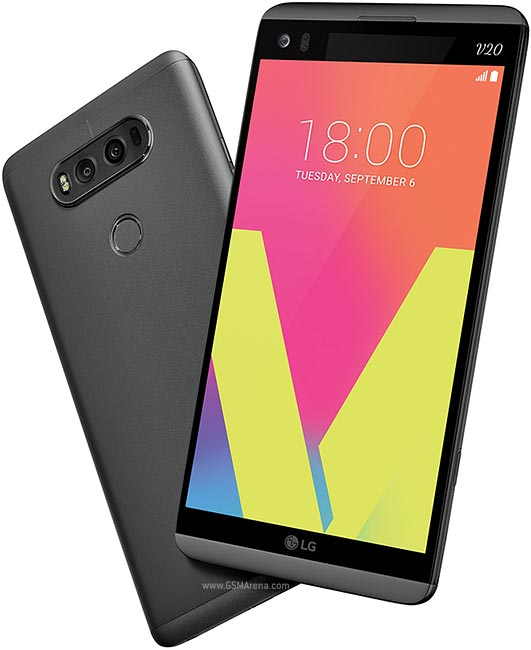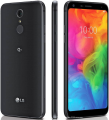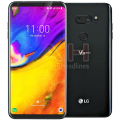
LG V20 Prices
Important Note.
- All prices are in Pakistani Rupee (PKR)
- Prices may vary at stores and our effort will be to provide you with the updated prices.
- Find out WhatMobile price has dropped in Pakistan by selecting Notify Price Drop button
- Find out WhatMobile has better specifications by clicking Add To Compare Button find out what Mobile has better reviews by visiting our reviews section
- Find out WhatMobile is cheaper on which retailer by clicking Compare prices from retailers button
Search Terms
- LG V20
Specifications
| GENERAL | |
| 2G Network | GSM 850 / 900 / 1800 / 1900 - all versions CDMA 800 / 1900 - Verizon |
|---|---|
| 3G Network | HSDPA 850 / 900 / 1900 / 2100 - Verizon HSDPA 850 / 1700(AWS) / 1900 / 2100 - T-Mobile HSDPA 850 / 1900 / 2100 - AT&T CDMA2000 1xEV-DO - Verizon |
| 4G Network | LTE band 1(2100), 3(1800), 7(2600), 8(900), 20(800) - EMEA LTE band 1(2100), 2(1900), 3(1800), 4(1700/2100), 5(850), 7(2600), 12(700), 29(700), 30(2300) - AT&T |
| Sim | Nano-SIM - MIL-STD-810G certified |
| Announced | 07/09/2016 |
| BODY | |
| DISPLAY | |
| Display Size | 5.7 inches |
| Resolution | 1440 x 2560 pixels (~515 ppi pixel density) |
| MultiTouch | Yes |
| Protection | Corning Gorilla Glass 4 - Secondary display, 160 x 1040 pixels, 2.1 inches |
| SOUND | |
| AlertTypes | Vibration; MP3, WAV ringtones |
| LoudSpeaker | Yes |
| 3.5mm jack | Yes - 32-bit/192kHz audio - Active noise cancellation with dedicated mic |
| MEMORY | |
| CardSlot | microSD, up to 256 GB (dedicated slot) |
| Internal | 32 GB, 3 GB RAM |
| DATA | |
| GPRS | Class 33 |
| EDGE | Class 33 |
| Speed | HSPA 42.2/5.76 Mbps, LTE Cat6 300/50 Mbps |
| WLAN | Wi-Fi 802.11 a/b/g/n/ac, dual-band, Wi-Fi Direct, DLNA, hotspot |
| Blue Tooth | v4.2, A2DP, LE, aptX |
| InfraredPort | Yes |
| NFC | Yes |
| USB | Yes |
| CAMERA | |
| Camera Primary | 16 MP, laser autofocus, OIS, LED flash |
| Camera Features | Geo-tagging, touch focus, face/smile detection, panorama, HDR |
| CameraVideo | 2160p@30fps, 1080p@30fps, 720p@120fps, HDR, stereo sound rec. |
| CameraSecondary | 5 MP Duo |
| FEATURES | |
| OS | Android OS, v7.0 (Nougat) |
| Sensors | Fingerprint, accelerometer, gyro, proximity, compass, color spectrum |
| Messaging | SMS(threaded view), MMS, Email, Push Mail, IM |
| Browser | HTML5 |
| Radio | FM radio |
| GPS | Yes, with A-GPS, GLONASS |
| Java | No |
| Colors | Various |
| Others | - Fast battery charging - MP4/DviX/XviD/H.265/WMV player - MP3/WAV/FLAC/eAAC+/WMA player - Photo/video editor - Document editor |
| BATTERY | |
| Battery | Removable Li-Ion battery |
| MISC | |
Reviews
21/02/2017 - 2:45pm

At first glance the LG V20 might seem like something of an oddity; it was awkwardly slotted in between last year’s LG G5 and this year’s yet-to-be-launched LG G6 flagship, it has a premium price tag, it’s a phablet, it has a weird dual-display setup, and it was only made available in specific world regions (yet again, we in the UK get left out).
But with all that said, there’s a lot to like about this phone. It’s getting rave reviews in most places you care to look, and in no small part this is due to the fact that it is innovative, quirky, and feature-packed. The price might be a bit high, but you certainly get a lot of stuff for all that dough.
So without further ado, let’s take a look at what makes the LG V20 such an appealing handset.
LG V20 Design: Premium Build, Durable, Removable Battery
Following on from the LG G5, the LG V20 presents a similar largely metal design language which is highly premium to behold and handle. It’s a nicely proportioned, slim, and relatively lightweight device with a solid feel in the hand, and it packs a massive display tightly into the confines of its bodyshell - those bezels are super thin.
The back panel is a removable piece of aluminium, making it less fiddly than the LG G5’s removable end cap for switching the much-welcome removable battery - the cell itself is rated at 3,200mAh, so is nice and large. It also puts to bed that nonsense about metal build phones requiring a unibody design (although that argument can be made for waterproofing, which the LG V20 lacks). The handset isn’t entirely metal, however, with the end-caps being made from a high-end polycarbonate composite, which doesn’t detract from that premium aesthetic and feel. LG has also made efforts to ensure the LG V20 is robust, and it can take quite a beating compared to your average handset.
LG V20 Hardware: High Quality QHD Display, Innovative Secondary Display
One of the LG V20’s most unusual and standout features is the inclusion of not one, but two display panels. The primary display is a pretty standard high-end setup; a 5.7in IPS LCD with a 1440 x 2560 QHD pixel resolution at 513 pixels-per-inch and with a 72.4% screen-to-body ratio. It’s a decent size, plenty sharp, and has good colour, brightness, and contrast. The second display at the top of the phone’s fascia is a 2.1in “Ticker” display with a 160 x 1040 pixel resolution. This is “Always On” for information like the time and date, and provides notification alerts, as well as quick access controls for favourite apps and key settings. The screen has been improved over the LG V10 to allow for more characters to display longer messages and notifications, and it’s also brighter.
LG V20 Hardware: Smooth Performance
The LG V20 just missed the boat for the Qualcomm Snapdragon 821 and is instead using the Qualcomm Snapdragon 820; the same chip found in the LG G5. Not that this is such a big deal, it remains an extremely capable chip; the differences between the 820 and 821 are not huge, and, in terms of LG’s line-up, is not going to be topped anytime soon. It’s understood the LG G6 will still use the Snapdragon 821 rather than making the jump to the Snapdragon 825.
Samsung has hogged all of those, apparently, so that does mean the LG V20 and LG G6 will not be as speedy as Samsung’s Galaxy S8 flagship, but still, do not expect the LG V20 to be a slouch by any means. It has 4GB of RAM to keep things ticking smoothly, and functions extremely well with the combination of Android Nougat and the LG UX 5.0+, a well-optimised combo that does compliment the quad Qualcomm Kryo cores and Adreno 530 GPU nicely.
However, it’s worth noting that carrier-locked LG V20’s do tend to be chock-full of extra bloatware, so expect that performance to take a hit in this case; it is probably better to buy an unlocked model if possible.
LG V20 Hardware: Plenty Of Storage & Connectivity, Plus High Quality Audio
Onboard storage is a fairly spacious 32GB or 64GB plus microSD support for cards up to 256GB. Connectivity wise, the LG V20 is well-stocked with full 4G LTE support, Wi-Fi (including Direct, DLNA, and Hotspot), NFC, Bluetooth, GPS, and Type-C USB. It also features a fingerprint scanner and fast charging support.
The LG V20’s audio and multimedia capabilities are some of the best on the market. It features a Hi-Fi audio mode with four DAC (digital-to-analogue converters) and an ESS Sabre ES9218, delivering superb sound quality for MP3’s and FLAC files. It’s Bang & Olufsen Play certified, supports 32-bit/192kHz audio recording and LPCM 24-bit/48kHz audio recording on videos, together with active noise cancellation via three dedicated microphones. Despite all of this, the sound experience is best heard through the 3.5mm headphone jack, as the single speaker grille is fairly mediocre, sadly.
LG V20: Best Places To Pick One Up In The US
If you’re in the US, the LG V20 is available from most major carriers. Below are a selection of some of the best deals we’ve seen.
LG V20 Verizon Deals
You can pick up the LG V20 from $24 a month on 24 month contracts. Or, if you fancy going the SIM-free route, $576.
LG V20 Sprint Deals
Sprint’s deals for the LG V20 start from $33 a month and you won’t have to pay a DIME for the handset.
The best option, or, the one I’d go for is the Unlimited Plan, which nets you Unlimited Data, Talk, Text, HD video and 10 GB Mobile Hotspot.
The SIM-free route will set you back $729
LG V20 AT&T Deals
Prices start at $27.67 per month at AT&T with two other options: Next Every Year, where you can trade the phone in for a new model in March, 2018; or, SIM-free which will cost you $829.99.
LG V20 T-Mobile Deals
T-Mobile’s ONE Plan will set you back $69.99 – it’s usually $100 – but it is one of the most robust options available, as you get 2 unlimited lines with AutoPay, unlimited calls and unlimited data.
I like having unlimited data, so I would probably go for this one.
Write Your Own Review
My Recent Reviews
- Be first to post review for this product.
comments powered by Disqus














-16-GB.jpg)


-16-GB.jpg)
.jpg)











